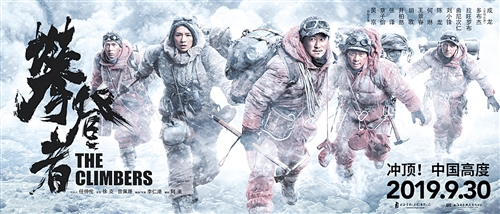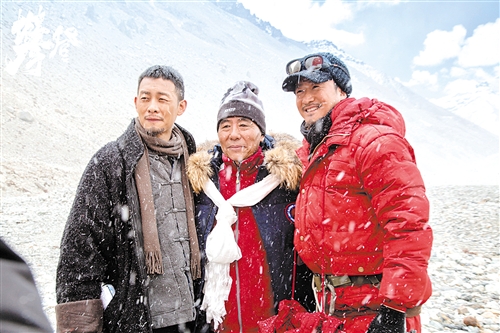The "climber" Sangzhu restored the historical details and recalled the 70-minute anaerobic measurement of Mount Everest


Wu Jing (right), Zhang Yi (left) and Sang Zhu (middle), the hero of climbing Mount Everest
Photographer, Jing Boran
As the photographer of the 1975 mountaineering team, Li Guoliang was tasked with a major mission: to capture the great moment of the Chinese mountaineering team climbing Mount Everest with a camera.
"He is a little hero with flesh and blood and emotions, but he is not good at expressing himself. In his heart, his mission is greater than anything else."
Captain, Wu Jing
Fang Wuzhou, the leader of the prototype mountaineering team: "During the filming process, we also restored the equipment of the climbers back then. Although the conditions at that time were very simple, they still overcame difficulties and finally completed the task of climbing Mount Everest. This also confirms the courage of the older generation of mountaineering heroes."
● Meteorologist, Zhang Ziyi
As a meteorologist, Xu Ying’s greatest hope is not only to climb the mountain and test the weather changes, but also that they can safely descend the mountain.
"It’s an honor to be able to participate in this film. As actors, we have learned a spirit of never giving up, and the whole shooting process is unforgettable."
● Deputy Commander-in-Chief, Zhang Yi
In the movie, Qu Songlin was one of the members who reached the summit in 1960. Due to severe frostbite from climbing the cliff barefoot, his toes were later amputated. In 1975, he served as the deputy commander of the front line of the summit operation. "The climbers overcome all obstacles and difficulties with extraordinary courage and perseverance, and pay tribute to the heroes."
● Team member, Hu Ge
The prototype Yang Guang took his father’s expectations and his own dreams to the top of the coveted Mount Everest Snow Mountain.
"Every climber is also a practitioner. Mountaineering is really a contest with the god of death."
The film "The Climber" will be released on September 30. The film is mainly based on the deeds of the Chinese mountaineering team who reached the summit of Mount Everest in 1975. The reporter interviewed Sang Zhu, a member of the 1975 Mount Everest climbing team, and listened to him tell the true experience of that year.
The crew of "The Climber" contacted Samdrup, who had retired at home, in the first half of last year to conduct a detailed interview on the climbing process and details of that year. Samdrup revealed that the film’s creative team consulted him and Xia Boyu, another member of the Han mountaineering team of the assault group, for many details of the climbing that year. The experiences of different ethnic groups are also reflected in different characters in the film, but they did not copy the characters and stories. For example, during the second climb, there was no large-scale avalanche. The mountaineering clothes of that year were lake blue clothes and red pants, and they were not the red ones in the film.
■ Interview
The red flag was carried all the way, and the whole team hugged and cried when they reached the summit
Joining the mountaineering team: the coach is very satisfied
In 1952, Sangzhu was born in Shigatse, Tibet, where the average altitude is over 4,000 meters, and joined the army at the age of 17.
In 1974, 22-year-old Sangzhu received a task from the army. The Chinese mountaineering team climbing Mount Everest was recruiting members in Naquru County, where Sangzhu’s army was located, and asked him to report quickly. When Sangzhu reported, the size of the reserve team had reached 1,000 people. Sangzhu recalled: "The selection of the reserve team is very strict. The requirements must reach 1.75 meters, and they must not be short-sighted or left-handed. Their physical fitness must be good." In late March 1974, more than 100 members were taken to the Everest base camp at an altitude of 5,200 meters for alpine adaptation training until they reached the camp at an altitude of 7,028 meters. In August of the same year, Sangzhu followed the team from Lhasa to Huairou, Beijing for training until March of the following year. Sangzhu said, "I was young at that time, my body was very good, and I didn’t respond when I reached 7,000 meters above sea level. I could eat very well. The coach was very satisfied."
After multiple rounds of physical fitness tests and rigorous selection, Samdrup successfully became a member of the mountaineering team, which included a total of 434 scientific research and logistics personnel, including 38 female team members.
Preparation: Initially just "alternates"
Before climbing Mount Everest for the first time in 1960, the state allocated $700,000 as a special project fund for Mount Everest, and also purchased 6 tons of mountaineering equipment from Switzerland, but it was very difficult to transport the materials and manpower to the camp above 7,000 meters above sea level. After more than ten years, the materials were scarce. Sangzhu mentioned in an interview that the down suits and climbing boots he wore were left by the old team members, which were very old, and the equipment used in the process of climbing was also very simple, and sometimes only simple seat belts, ropes, and plastic shoes.
"Before the climb, the down factory in Shanghai specially made mountaineering suits for us. It was lake blue clothes and bright red pants. At that time, it was very rare and fashionable, and everyone was very happy when they got it," Mr. Sang said.
When he first joined the mountaineering team, Sangzhu was not the main team member of the assault peak, but a member of the road construction team. He was responsible for building roads, pulling ropes, setting up metal ladders, and transporting supplies. He needed to repair them all the way to an altitude of 8,100 meters. However, due to the severe frostbite of the commando team, he replenished the team members from the road construction team, and Sangzhu was also among them.
Climbing to the top: Measuring the standard height of Mount Everest
On the evening of May 26, 1975, 129 mountaineers were divided into six teams and began their ascent to the summit of Mount Everest. Since the second ascent of Mount Everest required not only the completion of the task of reaching the summit, but also the mapping work, all the equipment, labels, and five-star red flags were carried by the team members step by step after setting up the metal ladder.
At 14:30 on May 27, 1975, nine members of the Chinese mountaineering team successfully reached the summit of Mount Everest again, and worked in an anaerobic environment for 70 minutes, successfully measuring the precise height of Mount Everest and completing the feat. "At that time, we measured the standard height of Mount Everest at 8848.13 meters, and also erected the target on it, which became the’ironclad proof ‘of reaching the summit."
Speaking of the moment of reaching the summit that year, Sangzhu was still very excited: "At that time, I took the red flag out of my backpack, and I carried the red flag all the way. The nine members of our final summit team were Han, Tibetan, and lesbian. They couldn’t stop hugging and crying, and they were very excited." Completely forgetting the anaerobic environment and the overdraft state of his body, that state also made the young man determined to engage in mountaineering for the rest of his life. According to the Beijing News